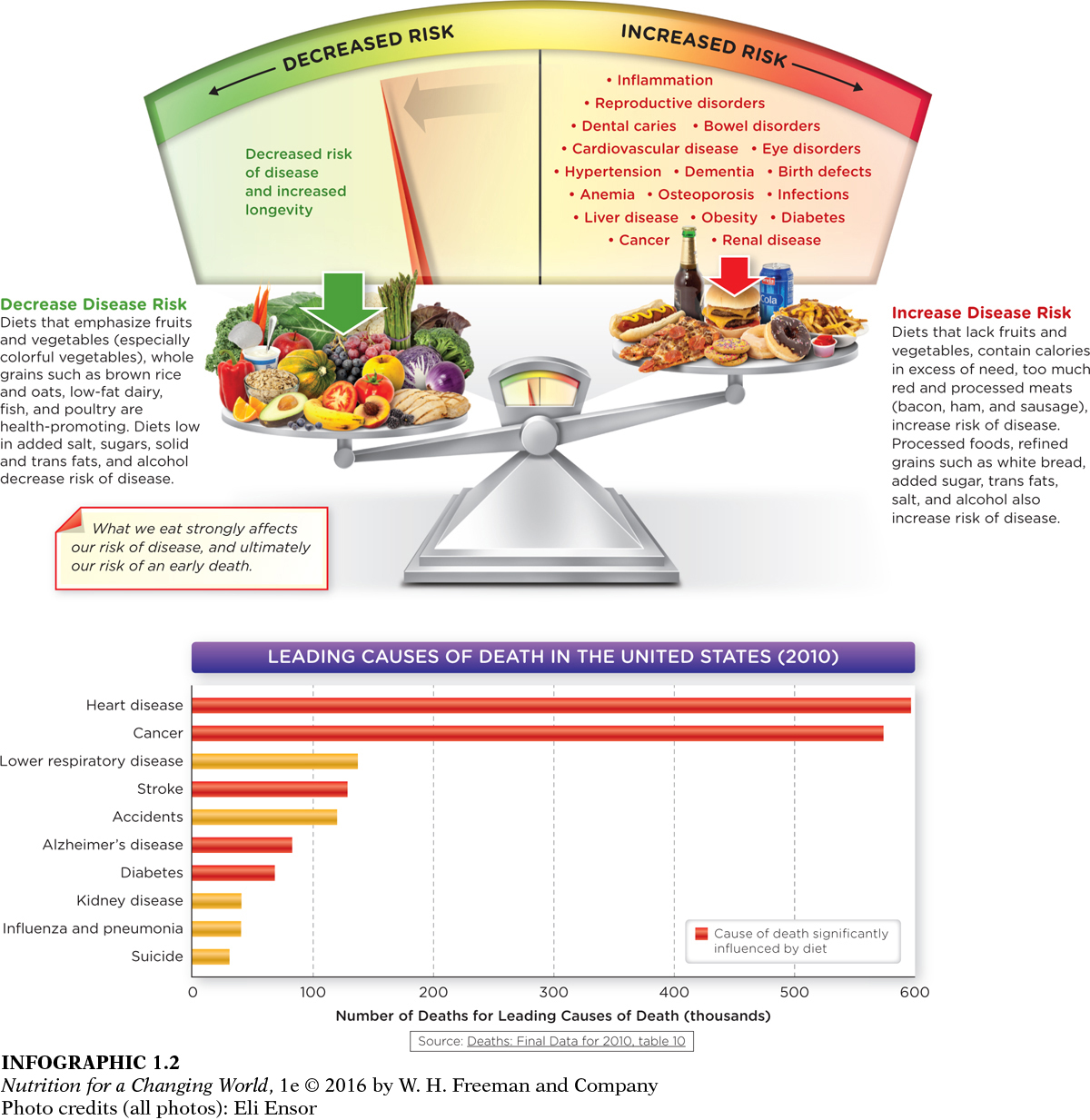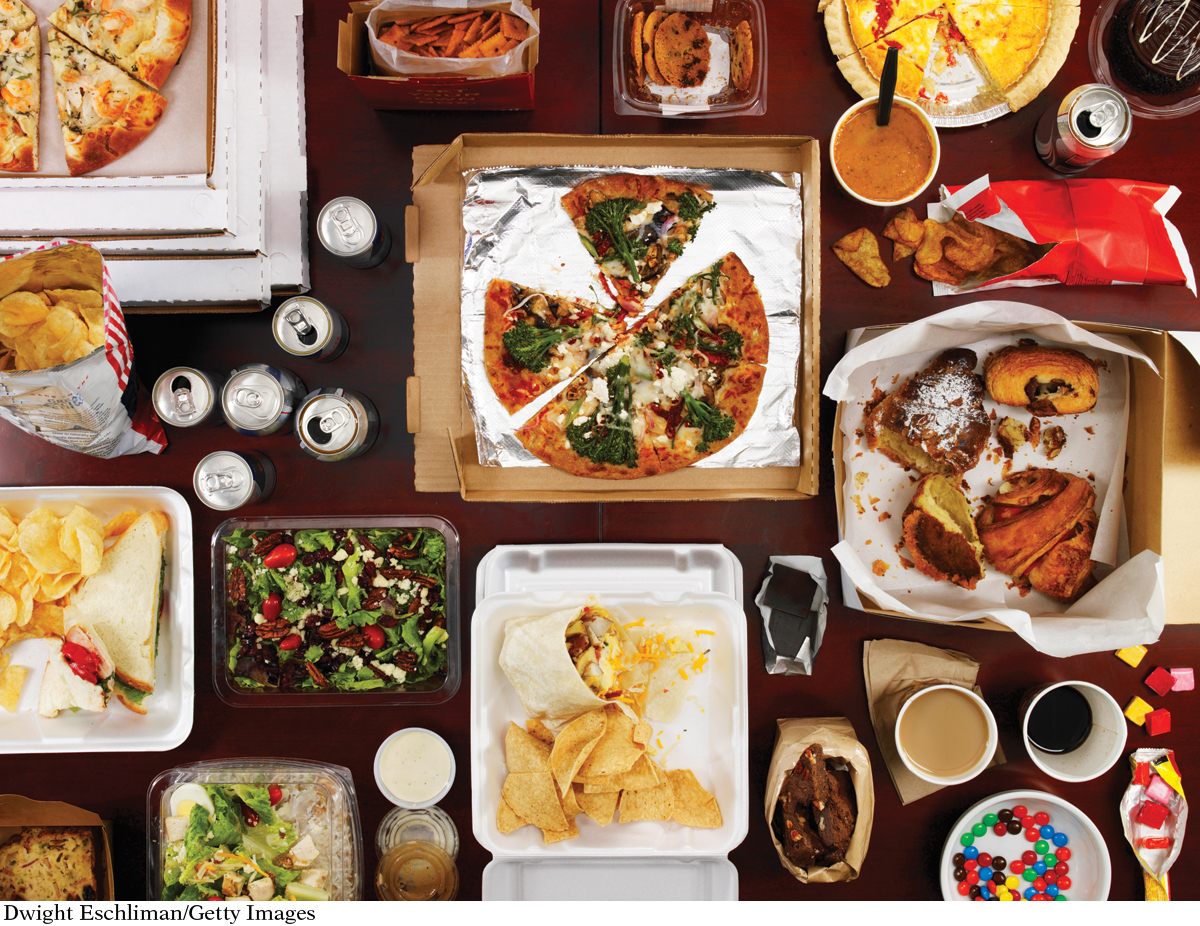FOOD PROVIDES NUTRIENTS AND ENERGY
Nutritionists study food and the components that make up food, including nutrients. A nutrient is a chemical substance that is essential for growth and to maintain proper body functioning. The body can actually produce many of its own nutrients, but other essential nutrients (such as water) must be supplied through what we eat and drink because the body cannot produce them or enough of them on its own.
NUTRIENTS
chemical substances obtained from food that are essential for body function; needed for metabolism, growth, development, reproduction, and tissue maintenance and repair
ESSENTIAL NUTRIENTS
nutrients that must be supplied through food because the body itself cannot produce/synthesize sufficient quantities to meet its needs
There are six classes of nutrients required for the body to function: carbohydrates, proteins, fats, vitamins, minerals, and water. What you eat: the specific quantity and variety of nutrients in foods can promote health or increase your risk of disease. (INFOGRAPHIC 1.2)
CARBOHYDRATES
compounds made up of carbon, hydrogen, and oxygen atoms that are found in foods as either simple sugars or complex carbohydrates (starch and fiber)
PROTEINS
large molecules consisting of carbon, hydrogen, oxygen, and nitrogen assembled in one or more chains of amino acids
FATS
a term for triglycerides, a subclass of lipids, that are the primary form of fat in our food and our bodies
VITAMINS
organic compounds that are required in small quantities for specific functions in the body
MINERALS
inorganic individual chemical elements obtained through foods that are essential in human nutrition
WATER
an essential nutrient that has critical functions in the body
4

Question 1.2
 What three types of foods increase risk of disease when overconsumed, and what three types of foods increase risk of disease when underconsumed?
What three types of foods increase risk of disease when overconsumed, and what three types of foods increase risk of disease when underconsumed?
Foods that increase the risk of disease when overconsumed include processed meats such as bacon and ham, other processed foods such as those with refined grains and added salt, and foods with added sugar.
Foods that increase the risk of disease when underconsumed include fruits and vegetables, whole grains, low-
5
All six classes of nutrients regulate numerous body processes, and most supply the building blocks of key body structures, such as cell membranes, muscles, and bones. They are required for normal growth, development, reproduction, maintenance, repair of cells, and other vital body processes.

Nutrients are divided into two major categories. The first is macronutrients, which we need in relatively large quantities to stay healthy—
MACRONUTRIENTS
term used to describe nutrients that we require in relative large daily amounts, e.g., carbohydrates, proteins, water, and fats
ENERGY
the capacity to do work; obtained through the breakdown of carbohydrates, proteins, and fats in foods and beverages

Question 1.3
 Given that alcohol supplies energy, why is it not considered a nutrient?
Given that alcohol supplies energy, why is it not considered a nutrient?
Alcohol is not a nutrient because, although it provides calories, it is a toxin. Alcohol does not support normal growth development, reproduction, maintenance, and repair of cells.
6
When we see calories listed on food labels, these are actually kilocalories (kcal) that reference the amount of energy in food. A kilocalorie is equal to 1,000 calories. By convention, when “Calorie” is spelled with a capital “C” it also refers to a kcal. The abbreviation “kcal” will be used throughout this book when discussing specific amounts of energy.
KILOCALORIES (KCAL)
standard unit to measure energy provided by food
The second category of nutrients is micronutrients, which are needed in much smaller amounts—
MICRONUTRIENTS
term used to describe nutrients essential in our daily diet to maintain good health, but required in only small amounts; e.g., vitamins and minerals

Question 1.4
 What is the energy content of vitamins? Of minerals?
What is the energy content of vitamins? Of minerals?
Vitamins and minerals are not a source of energy.
Another important part of the diet is phytochemicals (also known as phytonutrients), which are chemicals in plants that are beneficial to human health. Commonly found in vegetables, fruits, and whole grains, these compounds—
PHYTOCHEMICALS
compounds found in plant foods that are physiologically active and beneficial to human health; not considered essential nutrients
These macronutrients, micronutrients, and phytochemicals are extracted from food through the process of digestion (see Chapter 3 for more on digestion), and then absorbed and used by the body. Nutrients play a critical role in maintaining homeostasis, the process by which the body maintains a stable, internal environment in the face of external variability. For instance, nutrients in the foods we eat participate in processes that regulate the balance of fluids in the body, our pH, and our body temperature. As long as cells get the nutrients they require, all is well; when cells need more nutrients than are supplied, however, problems arise.
